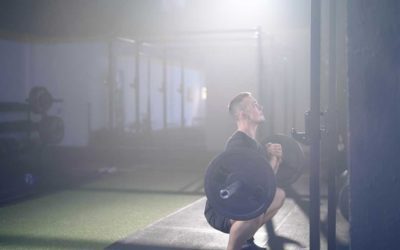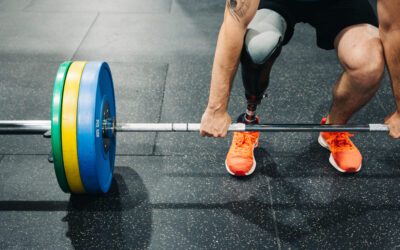4 Steps To Improving Your Pesky Shoulder Injury

Shoulder injuries are some of the most common in functional athletes. The high demands we place on our complex and intricate shoulder joints can mean tears, tweaks, impingements, and a whole host of nagging issues. Check out this blog and arm yourself with some reliable tactics for recovering from and preventing shoulder injuries.
Brandon Robb is the founder and head coach of HEROIC Athletics @heroic.athletics — he’s worked with athletes for over a decade. First responders (fire, police, military), golfers, Crossfitters, obstacle course racers, and hockey players all turn to him for performance gains, injury prevention, and competition prep.
brandon robb

Change the Way You Train
How to Heal Shoulder Injuries
Shoulder injuries are no joke. They can be frustrating, painful, and completely derail your training progress. Time and time again, I see athletes take HUGE steps back to deal with an injury.
You’ve probably heard the term R.I.C.E – which stands for Rest, Ice, Compression & Elevation. This term was actually coined in the 1970’s by Dr. Gabe Mirkin, MD, who actually recanted his original advice later in 2015 saying that ice and rest likely causes more of a delay in recovery than they do in support of recovery.(1)
Today, there are a number of acronyms that can work, but ultimately one of the best forms of recovery can be summed up in one word: movement. With a proper plan and approach, you can train around a pesky shoulder injury and come out stronger than ever.
I hold various certifications like Corrective Exercise Specialist and Mobility Specialist. I’ve been training clients for well over a decade. But at the end of the day, I don’t know your specific limitations and injury history.
Consult a physical therapist or medical professional on your own unique circumstances before implementing any new protocol. This guide is simply to provide you with ammo to ask your professional the right questions.
Step 1: Keep Training
In many cases, I encourage my clients to continue training while we modify their program around their shoulder injury so as not to exacerbate it. This may mean a temporary shift in program goals, but keeping consistent can help recovery in so many ways.
It may seem counterintuitive, but training while injured can actually help expedite recovery. First, continuing to train helps maintain your cardiovascular fitness, muscular strength, and prevent muscle atrophy, which can all aid in the recovery process (2, 4).
Exercise has been shown to have a positive effect on pain perception, mood, and overall psychological well-being, which often helps athletes cope with the stress and frustration of being injured (3, 5). It’s important to note that the type and intensity of exercise should be tailored to the injury and your capabilities, and should always be done under the guidance of a healthcare professional (6).
It just doesn’t make sense to throw away all your hard work and crush chips on the couch while you “get better” — even if your training now looks like taking frequent walks, focusing on your endurance capacity or hammering your posterior chain only. Just keep moving.
Step 2: Do Controlled Articular Rotations (CARs)
To start the recovery process, I focus on improving mobility and maintaining control of the shoulder joint. Controlled Articular Rotations (CARs) were my go-to for this step.
Check out this detailed video for how to perform shoulder CARs. Keep your focus on the rotational aspect and really hitting those end ranges without getting a pain response from your shoulder.
The key here is to remember the following:
- Make sure you that you are completing these small to start – avoiding pain.
- Gradually increase the range of motion each day/week over time to ensure proper progression and regain full access to the joint.
My wife (who is a physiotherapist) and I typically advise clients to start with “baby CARs” and gradually make them bigger over time. This helps get blood flow back into the joint and helps you regain range of motion sooner than later in the process.
Step 3: PAILs & RAILs
There are three ways in which a muscle usually contracts: concentrically (muscle gets shorter), eccentrically (muscle gets longer) or isometrically (the muscle length remains unchanged, as the force being applied is equal to the force you are able to use).
Isometric contractions can be immensely helpful in creating stability. Think of a regular plank hold — nothing is moving. But it is a shit-ton of work to hold it over time. Same goes for if you tried to stand a back squat up that was just a little too heavy. You sit at the bottom of a squat and re-evaluate your life choices, while you try with everything you can to stand up. That is essentially an isometric contraction: trying to move the joint/limb/weight/etc, but the force on you is more than you can move.
Once you have better range in the affected joint, you can implement some PAILs & RAILs protocols to help you build back stability in the joint with little risk for re-injury.
Caution here, the goal is to always remain pain free. Discomfort = good. Pain = bad.
PAILs (Progressive Angular Isometric Loading) and RAILs (Regressive Angular Isometric Loading) are isometric loading protocols that were a game-changer for me in bouncing back from my own shoulder injury.
External Rotation
Felxion
Extension
These two are also incredibly useful, depending on your symptoms:
Again, my professional advice is to NOT try these completely on your own. Pony up, pay for a session with a knowledgeable and certified PT, and make sure you’re executing these movements correctly.
Step 4: Start Adding Load
Say you’re on vacation with the family at an all inclusive resort. Dinner time rolls around and you decide to hit the buffet. This particular buffet is known around the world for having the best, most delicious food from all over the world. So you go all in, load up your plate with all your favorites.
You sit down at the table and see your spouse has loaded their plate with food you didn’t even see. You get up and grab a second plate. Next thing you know, you have 3 empty plates, 4 empty dessert plates and a stomach ache.
When coming back from an injury, don’t try and jump head first into all of your training. The key here will be to GRADUALLY add weight back into your upper body workouts.
This stage often carries the greatest risk for re-injury, as many athletes feel they’re 100% recovered, but in reality their joint is only about 70-80% ready.
Make sure that you take things slow. Lift lighter weights than you think you should and increase VERY gradually.
This approach, combined with an effective warm up and proper progressive training plan, will have you back to slaying it in the gym pain free.
Good luck in your training, Heroes.
References
- Mirkin, G. (2019). Why Ice Delays Recovery. Dr. Gabe Mirkin’s Fitness and Health E-Zine. Retrieved from https://www.drmirkin.com/fitness/why-ice-delays-recovery.html
- Loenneke JP, Wilson JM, Marin PJ, Zourdos MC, Bemben MG. Low intensity blood flow restriction training: a meta-analysis. Eur J Appl Physiol. 2012;112(5):1849-1859.
- Penedo FJ, Dahn JR. Exercise and well-being: a review of mental and physical health benefits associated with physical activity. Curr Opin Psychiatry. 2005;18(2):189-193.
- Roig M, O’Brien K, Kirk G, et al. The effects of eccentric versus concentric resistance training on muscle strength and mass in healthy adults: a systematic review with meta-analysis. Br J Sports Med. 2009;43(8):556-568.
- Schuch FB, Vancampfort D, Richards J, Rosenbaum S, Ward PB, Stubbs B. Exercise as a treatment for depression: A meta-analysis adjusting for publication bias. J Psychiatr Res. 2016;77:42-51.
- Topp R, Woolley S, Hornyak J 3rd, Khuder S, Kahaleh B. The effect of dynamic versus isometric resistance training on pain and functioning among adults with osteoarthritis of the knee. Arch Phys Med Rehabil. 2002;83(9):1187-1195.
Find Your Perfect Training Plan
Sometimes all you need to reach your destination on your fitness journey is an expert guide. We've got you covered. Browse from thousands of programs for any goal and every type of athlete.
Try any programming subscription free for 7 days!
Related articles
How To Zercher Squat: One Exercise To Rule Them All
I have a secret weapon exercise that will get us really close; it has a lot of bang for its buck. It builds massive quads, big glutes, a wide back, and some awesome biceps. Exactly what every athlete needs.
What Does Paralympic Strength Training Look Like?
Paralympians undergo rigorous training when preparing for the Paralympic Games. While the Paralympics only last about two weeks, getting ready takes place all year, as these athletes are among the most dedicated in the world. Here’s how people with disabilities...
Your Guide to Passive Recovery Strategies
What is Passive Recovery? I don’t think that there exists a complete guide for athletes that tackles the underrated topic of “Recovery-Regeneration” strategies. I plan to disclose a majority of the scientific and practical information that I know of on this topic and...

Join the community
Sign up for the latest training news and updates from TrainHeroic
Support
Made with love, sweat, protein isolate and hard work in Denver, CO
© 2023 TrainHeroic, Inc. All rights reserved.







